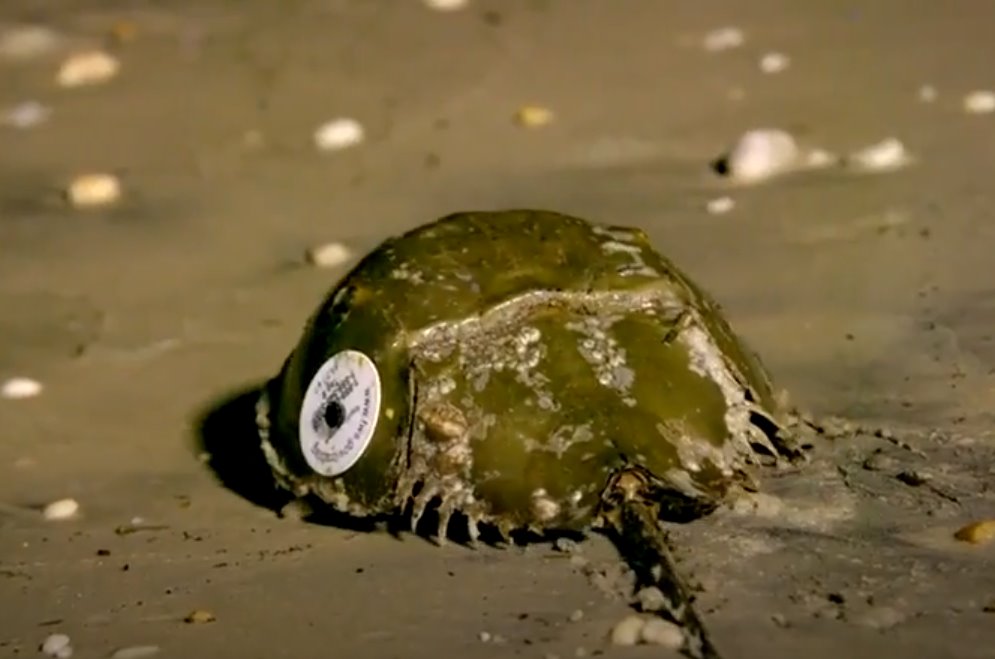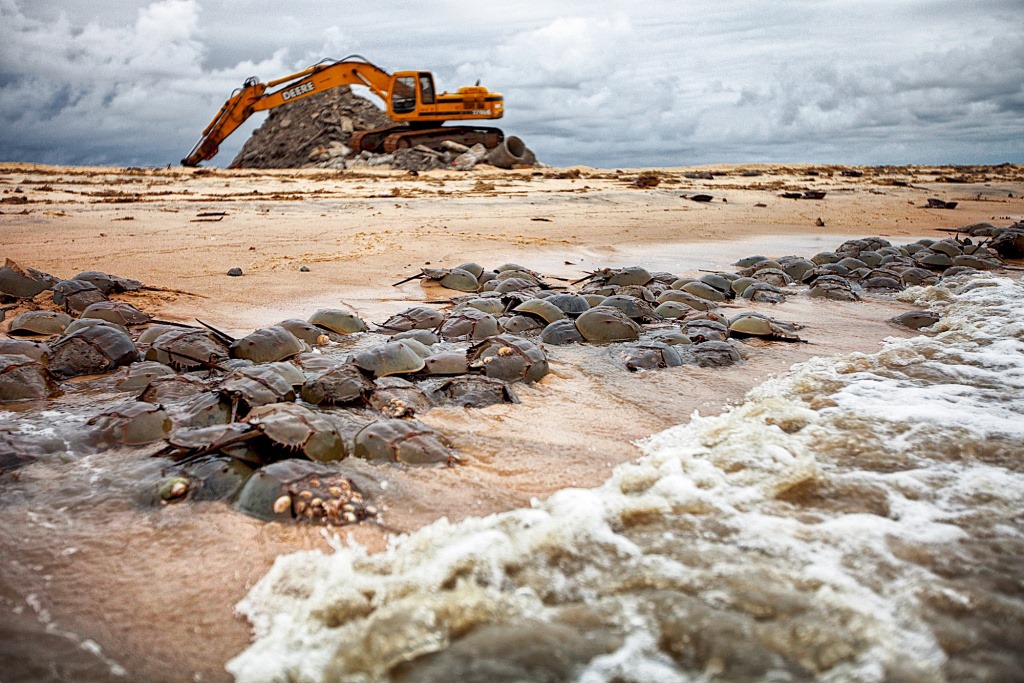Someone you love probably owes his or her health to a living fossil.
How can this be?
Well, it is because of the properties of the blue blood of the “living fossil.” Pharmaceutical companies are able to use this blue blood to test for harmful contaminants in vaccines and medical devices such as knee replacements, heart stents, and intravenous solutions.
The marvelous, mysterious “living fossil” is an iconic wildlife species in New Jersey! The largest population in North America spawns in Cape May County along the Delaware Bay beaches.
Which creature is this true blue blood?

It is the Atlantic Horseshoe Crab, Limulus polyphemus, which has been around for over 400 million years. Their blue blood contains Limulus amebocyte lysate (LAL) which clots in the presence of contaminating bacterial endotoxins. As the development of a COVID-19 vaccine progresses, LAL will be used to test for contaminants of all ingredients used during manufacturing and in the final product.
LAL is obtained from harvested horseshoe crabs that are transported to facilities that remove up to 30% of their blood, then return them to the water. Harvesting and bleeding do cause a mortality rate estimated at 15% to 30%. In addition, bleeding may impact female crabs so that they are unable or unlikely to reach the beach to lay eggs. This impacts several endangered shorebirds that depend entirely on horseshoe crab eggs when they stop to feed and rest on the Delaware Bay shore during their spring migration to northern nesting sites.

A synthetic LAL, known as recombinant Factor C (rFC), that would eliminate the need for bleeding horseshoe crabs, exists. However, it is not now listed in the U.S. as an equal alternative to LAL due to a lack of long term testing and only one pharmaceutical company has so far agreed to use it. LAL is considered an equal alternative in Europe.
The divergence of opinion on the use of natural versus synthetic LAL is an important human health and conservation issue.
Drug companies state that only a relatively small amount of additional production of LAL would be sufficient to test COVID-19 vaccines. Conservationists, who dispute this estimate, believe that rFC is a necessary alternative. They have concerns for the impact on horseshoe crab populations that have suffered drastic decline regionally and for the marine food chain that depends on them.
Another voice in the discussion is that of aquaculture advocates. They offer that “farming” a subpopulation of horseshoe crabs in captivity could supply enough LAL to support vaccine production until the regulatory body approves a less complex process for the use of synthetic lysate.
For a very readable, more detailed article about this concern, read the National Geographic article below.
[visual-link-preview encoded=”eyJ0eXBlIjoiZXh0ZXJuYWwiLCJwb3N0IjowLCJwb3N0X2xhYmVsIjoiIiwidXJsIjoiaHR0cHM6Ly93d3cubmF0aW9uYWxnZW9ncmFwaGljLmNvbS9hbmltYWxzLzIwMjAvMDcvY292aWQtdmFjY2luZS1uZWVkcy1ob3JzZXNob2UtY3JhYi1ibG9vZC8iLCJpbWFnZV9pZCI6LTEsImltYWdlX3VybCI6Imh0dHBzOi8vd3d3Lm5hdGlvbmFsZ2VvZ3JhcGhpYy5jb20vY29udGVudC9kYW0vYW5pbWFscy8yMDIwLzA3L2hvcnNlaG9lLWNyYWItaGFydmVzdGluZy8wMS1ob3JzZWhvZS1jcmFiLWhhcnZlc3RpbmctbmF0aW9uYWxnZW9ncmFwaGljXzEwOTIyNDMubmdzdmVyc2lvbi4xNTk0MDQ0NDkxMzk2LmFkYXB0LjE5MDAuMS5qcGciLCJ0aXRsZSI6IkhvcnNlc2hvZSBjcmFiIGJsb29kIGlzIGtleSB0byBtYWtpbmcgYSBDT1ZJRC0xOSB2YWNjaW5l4oCUYnV0IHRoZSBlY29zeXN0ZW0gbWF5IHN1ZmZlci4iLCJzdW1tYXJ5IjoiQ29uc2VydmF0aW9uaXN0cyB3b3JyeSB0aGUgYW5pbWFscywgd2hpY2ggYXJlIHZpdGFsIGZvb2Qgc291cmNlcyBmb3IgbWFueSBzcGVjaWVzIGFsb25nIHRoZSBVLlMuIEVhc3QgQ29hc3QsIHdpbGwgZGVjbGluZSBpbiBudW1iZXIuIiwidGVtcGxhdGUiOiJ1c2VfZGVmYXVsdF9mcm9tX3NldHRpbmdzIn0=”]
Several EarthShare New Jersey 501(c)3 member organizations including The Wetlands Institute, New Jersey Audubon Society, Conserve Wildlife Foundation of New Jersey, American Littoral Society, The Nature Conservancy, and EarthShare New Jersey corporate partners as well as individual community-based stewards have been working for many years to restore and sustain the population of horseshoe crabs in New Jersey.
To learn more about the work of The Wetlands Institute for horseshoe crab conservation, use the link below to watch a video overview of their research.
[visual-link-preview encoded=”eyJ0eXBlIjoiZXh0ZXJuYWwiLCJwb3N0IjowLCJwb3N0X2xhYmVsIjoiIiwidXJsIjoiaHR0cHM6Ly93ZXRsYW5kc2luc3RpdHV0ZS5vcmcvaG9yc2VzaG9lLWNyYWJzLyIsImltYWdlX2lkIjotMSwiaW1hZ2VfdXJsIjoiaHR0cHM6Ly93ZXRsYW5kc2luc3RpdHV0ZS5vcmcvd3AtY29udGVudC91cGxvYWRzLzIwMjAvMDEvd2V0bGFuZHMtbmV3LUFJXzIuanBnIiwidGl0bGUiOiJIb3JzZXNob2UgY3JhYnMgLSBUaGUgV2V0bGFuZHMgSW5zdGl0dXRlIiwic3VtbWFyeSI6IlRoZSBEZWxhd2FyZSBCYXkgY29udGFpbnMgdGhlIGxhcmdlc3QgY29uY2VudHJhdGlvbiBvZiBob3JzZXNob2UgY3JhYnMgaW4gdGhlIHdvcmxkLiBUaGVzZSBlbmlnbWF0aWMsIHVuYXNzdW1pbmcgY3JlYXR1cmVzIHBsYXkgYSBjcml0aWNhbCByb2xlIGluIHRoZSBjb2FzdGFsIGVjb3N5c3RlbTogZHVyaW5nIHRoZWlyIHNwcmluZyBzcGF3biwgdGhlaXIgZWdncyBoZWxwIG1haW50YWluIHRoZSBoZWFsdGggb2YgdGhlIERlbGF3YXJlIEJheSBmaXNoZXJpZXMgYW5kIHN1c3RhaW4gdGVucyBvZiB0aG91c2FuZHMgb2Ygc2hvcuKApiIsInRlbXBsYXRlIjoidXNlX2RlZmF1bHRfZnJvbV9zZXR0aW5ncyJ9″]
Still, there is concern about the 90% decrease in the Delaware Bay horseshoe crab population in the last 15 years. The population decrease has resulted from, biomedical harvest, bait fishing, discard mortality from commercial fish trawlers and shellfish draggers, habitat loss, and overturning by waves and stranding, all of which are still ongoing.
Horseshoe crabs are keystone species in the ecosystem. This means that they are a species which has a disproportionately large effect on its natural environment relative to its abundance. Many creatures depend on the horseshoe crabs for food and a substrate to grow on. For you and me, horseshoe crabs could be a path to a life-saving vaccine during the current COVID-19 pandemic!
Have you thanked a horseshoe crab today? Will you help them survive into the future? Here are some ways you can help:
1) Support EarthShare New Jersey and its programs raising operating funds for the state and national environmental organizations working to conserve horseshoe crabs for human and environmental health. Donate below.
[visual-link-preview encoded=”eyJ0eXBlIjoiZXh0ZXJuYWwiLCJwb3N0IjowLCJwb3N0X2xhYmVsIjoiIiwidXJsIjoiaHR0cHM6Ly9zZWN1cmUuZG9uYXRpb25wYXkub3JnL2VhcnRoc2hhcmVuai8iLCJpbWFnZV9pZCI6LTEsImltYWdlX3VybCI6Imh0dHBzOi8vc2VjdXJlLmRvbmF0aW9ucGF5Lm9yZy9lYXJ0aHNoYXJlbmovaW1hZ2VzL2xvZ28ucG5nIiwidGl0bGUiOiJFYXJ0aHNoYXJlIE5ldyBKZXJzZXkgfCBEb25hdGlvblBheSIsInN1bW1hcnkiOiJDb3B5cmlnaHQgwqkgMjAxNi4gRWFydGhTaGFyZSBOZXcgSmVyc2V5LiBBbGwgUmlnaHRzIFJlc2VydmVkLiBTaXRlIGJ5IFMtRlguY29tIiwidGVtcGxhdGUiOiJ1c2VfZGVmYXVsdF9mcm9tX3NldHRpbmdzIn0=”]
2) Adopt-A- Horseshoe Crab – No work required just a modest donation to the Wetlands Institute will support the care and rearing of eggs under controlled aquaculture techniques and release of young in the wild.
[visual-link-preview encoded=”eyJ0eXBlIjoiZXh0ZXJuYWwiLCJwb3N0IjowLCJwb3N0X2xhYmVsIjoiIiwidXJsIjoiaHR0cHM6Ly93ZXRsYW5kc2luc3RpdHV0ZS5vcmcvY29uc2VydmF0aW9uL2hvcnNlc2hvZS1jcmFiLWNvbnNlcnZhdGlvbi9hZG9wdC1hLWhvcnNlc2hvZS1jcmFiLyIsImltYWdlX2lkIjotMSwiaW1hZ2VfdXJsIjoiaHR0cHM6Ly93ZXRsYW5kc2luc3RpdHV0ZS5vcmcvd3AtY29udGVudC91cGxvYWRzLzIwMTAvMDUvQWRvcHQtSG9yc2VzaG9lLUNyYWItMDEuanBnIiwidGl0bGUiOiJBZG9wdC1BLUhvcnNlc2hvZSBDcmFiIiwic3VtbWFyeSI6IllvdSBjYW4gaGVscCEgQWRvcHQtQS1Ib3JzZXNob2UgQ3JhYiBpcyBhIHByb2dyYW0gdGhhdCBhbGxvd3MgWU9VIHRvIGNvbnRyaWJ1dGUgdG8gdGhlIGNvbnNlcnZhdGlvbiBvZiBIb3JzZXNob2UgQ3JhYnMuIFJlYWQgb24gdG8gbGVhcm4gbW9yZSEiLCJ0ZW1wbGF0ZSI6InVzZV9kZWZhdWx0X2Zyb21fc2V0dGluZ3MifQ==”]
3) reTURNtheFAVOR – Return any overturned horseshoe crabs you may find to their proper position using a couple of simple guidelines or join a guided seasonal rescue walk on a closed beach. Visit the link below for guidelines and to register
[visual-link-preview encoded=”eyJ0eXBlIjoiZXh0ZXJuYWwiLCJwb3N0IjowLCJwb3N0X2xhYmVsIjoiIiwidXJsIjoiaHR0cDovL3JldHVybnRoZWZhdm9ybmoub3JnLyIsImltYWdlX2lkIjotMSwiaW1hZ2VfdXJsIjoiaHR0cDovL3JldHVybnRoZWZhdm9ybmoub3JnL3dwLWNvbnRlbnQvdXBsb2Fkcy8yMDE0LzAxL1dlYi1IZWFkZXIucG5nIiwidGl0bGUiOiJyZVRVUk4gdGhlIEZhdm9yIiwic3VtbWFyeSI6IkZpbmQgdXBkYXRlcyBmb3IgdGhlIDIwMjAgUlRGIHNlYXNvbiIsInRlbXBsYXRlIjoidXNlX2RlZmF1bHRfZnJvbV9zZXR0aW5ncyJ9″]
Anne Galli
Passionate Environmentalist
Former EarthShare NJ Board Member